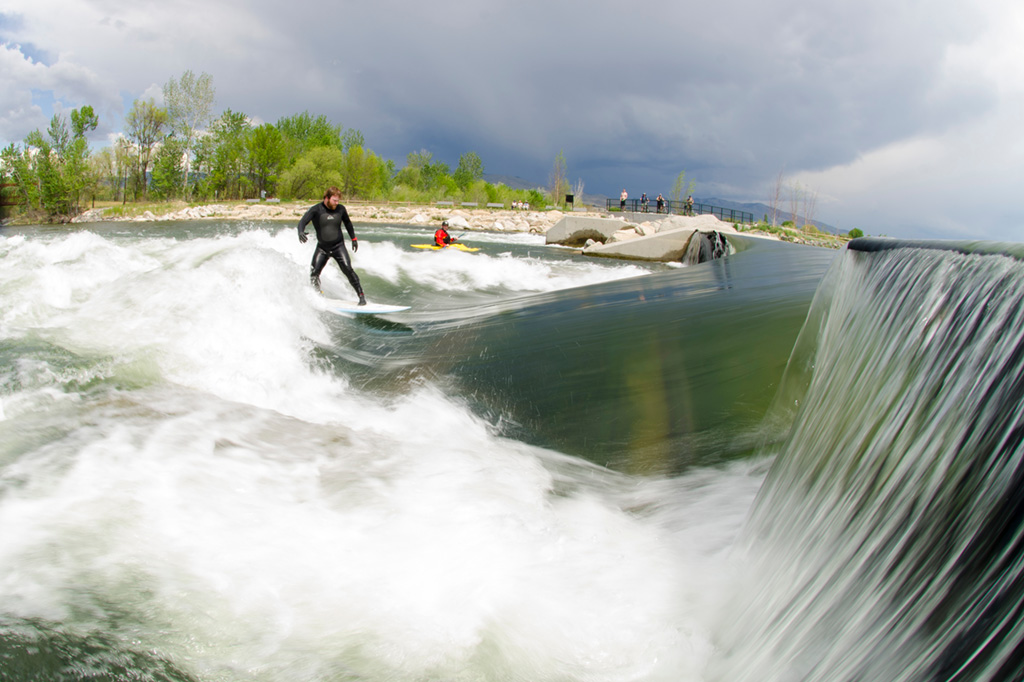When the heat of summer fully descends on the Treasure Valley, Boisean’s surge to the Boise River that flows through the heart of the city. This summer, with the opening of the Boise Whitewater Park’s second phase, the river will become an even bigger recreational draw.
The first phase of the Whitewater Park opened on the riverside of Esther Simplot Park in June 2012 with a full rebuild of the Thurman Mill Diversion dam. The original dam was a dangerous barrier of concrete and rebar that spanned the width of the river. That dam was removed and replaced with an adjustable Wave Shaper device, a patented technology that shapes flowing water into desired features. This created a place where water could be diverted safely for irrigation, while making a whitewater wave that could be used for recreation on demand.
For Doug Holloway, director of Boise Parks and Recreation, the popularity of that first phase of the park was expected, but what surprised him was the amount of surfers who flooded the park.
“It’s a little surprising to see that surfing has become such a major part of the usage,” He says. “It’s 50-50 kayakers and surfers … On a nice day, people lined up on the bank, waiting to get in to use the wave.”
The second phase of the Whitewater Park opens in July 2019, and, with three additional features and boulder seating on the banks, it will offer a complete playground for whitewater enthusiasts of all types, from kayakers and playboats to surfers and paddle boarders, as well as spectators. Paul Primus is the Whitewater Park wave technician who adjusts the waves for surfers, while Andrew Webb is the wave technician for kayaks and playboats.
The first new feature improved the Farmers Union dam with a mechanical wave different from the Wave Shaper used in the first phase. This one spans the width of the river and uses pneumatic gates to change the shape of the wave from a hole-style wave more suited to kayaks to a green wave geared toward whitewater surfers. The feature also diverts water into the Farmers Union canal adjacent to the park.
The other two new features are engineered boulder structures that also span the width of the river. These aren’t adjustable, but the waves created by them will change as water levels rise and fall. The boulders were placed in the river and filled in with concrete to prevent entrapments that can occur in natural rock formations.
Both whitewater surfing and kayaking are relatively new sports, and as they have evolved, safety concerns have become a priority for its enthusiasts. Paul Collins, a local orthopedic surgeon and avid whitewater kayaker, was part of a group of kayakers who first suggested the concept of a whitewater park to the city 30 years ago.
“We began to see the danger as boating began to grow,” he says. “Thirty some years ago, kayaking was a new sport and the way it used to work is, you would get in a huge boat and you would try to make it down the river. You never stopped to play or do anything like that.”
For a river that runs through a town with dams for irrigation canals, Collins saw an opportunity to make the dams safer, working with designers, like Scott Shipley who designed phase two, to create a safer environment.
Despite the safer nature of a man-made whitewater park, Primus urges users to take the same precautions they would on a naturally occuring wave. That includes avoiding leashes for surfboards, as there will be naturally occuring debris in the river that could cause issues.
Primus also hopes that the smoothness and consistency of the wave at the first feature will allow users to build their skills in a controlled environment.
“It will provide opportunity for people to progress to levels we haven’t even seen before,” Primus says. “It’s a pretty new sport, and I think this wave will provide the opportunity for that progression.”
The Whitewater Park’s new adjustable feature serves more than just a recreational purpose. It acts as a water diverter to push water from the river as it rises into the Farmers’ Union canal. This diversion can mitigate flood risks as water levels rise from dense snow pack, and it enticed Garden City residents, who live on the river’s banks closest to the park, to support the project.
David Eberle, formerly of the Boise City Council, lives on the river beside the park and served as a liaison from the Waterfront District Homeowners Association during the project. The parks department worked with residents during construction.
“The city offered to ensure a no net rise in heavy flooding,” he says. “The way it’s supposed to work, the neighborhood won’t flood, and the developer brought us above the floodplain, so the whole thing seems like a good idea from that perspective.”
The grand opening celebration of the park is slated for July. Another phase of the park is not currently in the works, but Collins and the whitewater community are hopeful that the dam at the Settler’s Irrigation District diversion, which can be seen upstream from Americana Boulevard, will be next in the line of reconstruction.
“People are going to be attracted to what’s downstream,” Collins says.

